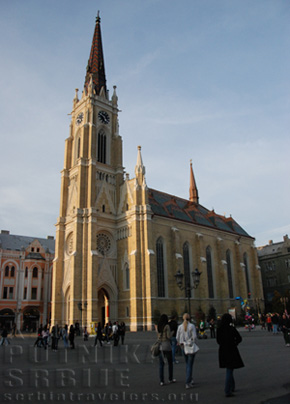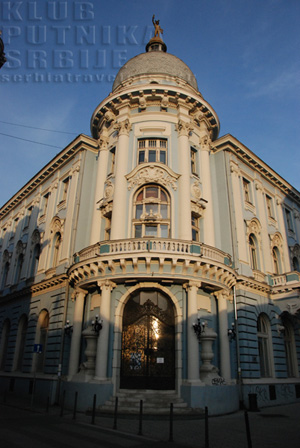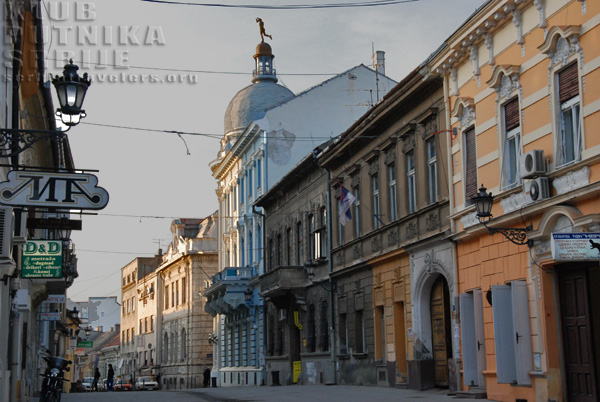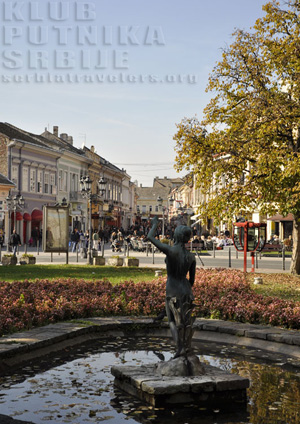 Novi Sad
Novi Sad
Take a walk down the picturesque Austro-Hungarian style streets of the city centre, explore one of the largest fortresses on the Danube river, and stroll around the authentic ancient town of Petrovaradin.
Take a look at the frescoes in Almaska and Saborna churches - the works of the great Serbian painters - or admire the stained glass windows of the Cathedral, made by Hungarian and Czech craftsmen in the 18th and 19th century
Don't miss upon the unusual architecture of the early 20th century Bishops' Court, and the large yellow brick Synagogue in Jewish Street.
Take the long winding stairway up to the Clock Tower and enjoy the panoramic view of the city, river, Fruska Gora mountain and the surrounding plain.
Finally, spend some time watching passers-by from one of the many benches in the Town Square or Dunavski Park.
History of Novi Sad
The history of Novi Sad begins in 1694, when a bridgehead was built on the northern bank of the Danube, opposite of the Petrovaradin Fortress,  that was at the time the stronghold of the Austrian army in their fights against the Turks.
that was at the time the stronghold of the Austrian army in their fights against the Turks.
Soon afterwards, a settlement started to grow around the bridgehead, inhabited mostly by soldiers, craftsmen and traders.
In 1702, an area called Danube Military Frontier was established as a buffer zone to protect Austria from the Ottoman Empire, and permanently inhabited by (mostly Serbian) soldiers and their families.
In 1738, when it became apparent that Austria is losing the war and that Belgrade is about to fall to the Turks, Serbs and Germans started to shift their properties up the Danube to Novi Sad, which was at the time still called Petrovaradin Rampart.
On February 1st, 1748, this town acquires the status of the Queen's Free Town and is given the name Neoplanta (in Latin), Neusatz (German), Ujvidek (Hungarian) and Novi Sad (Serbian). The name can roughly be translated as "New Garden".
Novi Sad is today the second largest city in Serbia, and the capital of Vojvodina, the northern semi-autonomous Serbian province.
Getting to Novi Sad
You can reach Novi Sad by car (it is on the E75 main road), bus or train.
Train station and the main bus station are situated next to each other, at the crossroads of the Bulevar Oslobodjenja and Jase Tomica streets. Bulevar Oslobodjenja is one of Novi Sad's main arteries, connecting the main train/bus station and the Most Slobode bridge.
Buses to Belgrade leave from the main bus station. During the rush hour there are buses at approx. every 10 minutes, while in the morning/evening they depart roughly every hour. One-way ticket costs about 6 Euros and the student/youth discounts are available depending on the transport company. The last evening bus leaves around 11 pm, and the first morning bus around 4 am.
Buses to Subotica go between 6am and 11pm.
There are ten daily trains to Belgrade from 5:28 am till 10:32 pm. One-way ticket costs about 3-4 Euros, depending on the kind of train.
Trains for Subotica leave from 4:34 am till 10:10 pm, and there are ten each day.
There is one daily train to Bar (Montenegro), leaving Novi Sat at 21:10.
As for the international trains, the train to Budapest and Vienna leaves every day at 11:45 pm.
At 9:51 am there is a train to Budapest that divides there into two lines - one for Kiev and Moscow and the other one for Gyor and Vienna.
What to see in Novi Sad?
Old City Centre
The old town center runs along Zmaj Jovina, Dunavska and Kralja Aleksandra Streets. Most of the buildings in these street were built in the 19th and the early 20th century, with some exceptions dating back to the 18th century.
The very heart of Novi Sad is the Town Hall, and at the opposite end of the Town Square is the Catholic church, usually called "Katedrala" (the Cathedral), which is the no. 1 meeting point in Novi Sad. If you have to meet someone, the chances are they will tell you to wait in front of the Cathedral. It is actually a church dedicated to Virgin Mary, completed in 1985.
The church was built in neogothic style, with a clock on each side of the 76 metres tall bell tower. The roof and the tower are covered in multicoloured tiles and the windows are decorated by the stained glass designed by Czech and Hungarian craftsmen. 
Next to the church, there is a building known as the "Iron Man", aptly named after the statue of a knight in armor with a spear that can be seen in its upper facade.
Walking away from the Cathedral down Zmaj Jovina Street, where you will find some of the most beautiful old houses, you will reach the Bishops' Court ("Vladicanski dvor") built in 1904. This is the seat the Orthodox Bishop of Backa province. The walls are covered in red tiles, in a style that represetns an interesting mix between the romanesque and the baroque.
Left to the Court is the beginning Pasiceva Street, with the orthodox Assembly Church (Saborna crkva), dedicated to St. George.
Going a bit further down Pasiceva Street, you will come across the Matica Srpska building, a famous publishing house/library and one of the oldest and most important Serbian institutions.  You will know the building by its unique architecture, as well as some bronze busts in front of the main entrance.
You will know the building by its unique architecture, as well as some bronze busts in front of the main entrance.
On the right from the Bishops' Court there is Dunavska ulica (Danube Street), one of the oldest in town. First building, right at the corner of this street (diagonally from the Bishop's Court, just accross the street from the City Library) is known as the White Lion, erected in 1720, and is one of the oldest houses in Novi Sad.
At the end of the pedestrian part of Dunavska Street is Dunavski Park, with many different tree species and a miniature lake with and island and a family of swans.
Walking further down the Danube street, past the park, you will reach the Museum of Vojvodina (35-37 Dunavska Street; Open Tuesday to Saturday from 9 am to 7 pm, Sunday from 9 am to 2 pm. In July and August, open only from 9 am to 2 pm). The Museum contains archaeological, ethnological, art history, zoological, botanical, geological and mineralogical collections.
Going a little further down Dunavska Street will take you to the bank of the Danube, called the Quay.
The Quay is a long promenade by the Danube river, stretching along the whole length of the town's riverbank. The part just accross from the Petrovaradin Fortress is called the Raid Victims' Quay (Kej Zrtava Racije) and there is a monument and a memorial to the Novi Sad citizens killed in the Big Raid that took place on Orthodox Christmas 1942. On that day, numerous families were thrown under the Danube ice.
By crossing the Varadin Bridge you reach the oldest part of the city, called Petrovaradin, where the famous Petrovaradin Fortress is located.
Starting from the Cathedral in the opposite directiong and walking between the Town Hall and Mc Donald's restaurant, you will arrive to a large square where the building of Serbian National Theatre is placed. You'll easily recognize it as a flat, huge white building in characteristic communist style.
If you walk past the theatre, continue straight ahead, cross the street and walk past a new hotel resembling a giant radiator, you will enter Jewish Street (Jevrejska ulica). A couple hundred metres further down this street you will find the Novi Sad Synagogue to your left. It was built in 1909, on the location of an older building with the same purpose. Above the door there is a golden inscription in Hebrew saying "This is the place of prayer for all peoples". On the facade there is a memorial plate saying that all local Jews were collected in this synagogue in order to be taken to concentration camps. Today, the Synagogue is used as a concert hall. 
Another interesting structure is Almaska Church (Address: 15, Almaska Street), built in the late 18th century in neo-classicist style. The woodcarving work was done by Aksentije Markovic, and icons and part of the wall paintings were done by painter Aksentije Teodorovic. The icon of the Holy Virgin with Christ was painted by the famous Serbian painter Uros Predic in 1905.
Petrovaradin
Petrovaradin, today a part of Novi Sad and connected with the center by Varadin Bridge, was originally a 12th century settlement which used to play an important role in trade between the Byzantine Empire and Hungary. Bela IV, Hungarian king, bestowed Petrovaradin in 1237 to the Cistercite Monastery, the ruins of which have recently been dug out on the Fortress and can be seen right next to the museum. After the Tatar invasion (1247-1252) the Cistercites built a fortification to protect the monastery.
The old town of Petrovaradin today still looks exactly the same as it did several centuries ago. Houses are mostly one or two stories high, with many interesting archaeological details. The street that leads from the bridge into town is the main Petrovaradin street, and goes to the small tunnel or arch called the Belgrade Gate. Beyond that gate is the newer part of Petrovaradin, stretched along the main road.
The Church of the Lady of Snow (crkva Snežne Gospe), at the exit from Petrovaradin on the road to Karlovci, was built on the location of the great battle in which the Austro-Hungarian army, under the command of the Eugene of Savoy, defeated the Turks in 1716. It was built in neo-gothic style, has two towers and, inside, three altars for three main Christian denominations: Catholic in front, and Orthodox and Protestant on either sides of the entrance. In front of the church there is a crucifix erected in 1910.
Petrovaradin Fortress
The construction of the fortress started in 1247. In 1526 Turks took it over from the Austrians, under the rule of Suleiman II the Magnificent.
Austrian army regained possession of the Fortress in 1691, under the command of the lord Ludwig of Baden. The construction continued according to the project of a French military architect, Sebastian Vauban.
In 1694 the Austrians built, on the other side of the Danube, a triangle-shaped bridgehead around which Novi Sad will later grow. This bridgehead can still be seen and the monument for the victims of the Raid is placed on it.
The Petrovaradin Fortress today makes a pleasant place for walking and exploring. The long staircase that passes through a couple of wide tunnels reaches a plateau with a splendid view of the city. There is also the Clock Tower, considered to be the symbol of Novi Sad. The clock originates from Alsace and it was given to the city by the  Queen Maria Therese in early 18th century. It has never stopped working; keep in mind that the long hand shows hours, and the short one is for minutes.
Queen Maria Therese in early 18th century. It has never stopped working; keep in mind that the long hand shows hours, and the short one is for minutes.
The Fortress spreads over 112 hectares (about 230 acres) with a unique system of underground passages, some of which remain unexplored even today. Visiting a part of these passages is possible on a guided tour (10 am - 5 pm, closed on Mondays).
In the Fortress there is the Novi Sad City Museum (open daily 9 am-5 pm), whose permanent exhibition includes old furniture, paintings and everyday household objects from these parts from 18th-20th century.
Museums and galleries
Except for the Museum of Vojvodina (in the old town centre) and the Novi Sad City Museum (at the Fortress), the Natural Science Museum (address: Radnicka Street 20a, open daily 8 am-7 pm) can make an interesting visit, although its permanent exhibition is not very large.
As for the art galleries, the most important ones are at the Gallery Square ("Trg galerija"), at the beginning of Vase Stajica Street, in the very centre of the town.
The Gallery of Matica Srpska (Trg galerija 1, open Tue-Thu and Sat 10 am - 8 pm, Fri 12 am - 8pm, Saturdays for pre-arranged visits only) contains paintings from Vojvodina, dating from the 17th to 20th century. The Memorial Collection of Pavle Beljanski (Trg Galerija 2, open Wed and Fri-Sun 10 am - 6pm, Thu 1pm - 9pm) exhibits the works of Serbian painters from the first half of the 20th century.
Another interesting place is the Donation Collection of Rajko Mamuzic (Vase Stajica Street 1, open Wed-Sun 9 am - 5 pm) which holds the pieces of post-WW2 Yugoslav paintings and sculptures.
{/tabs}

